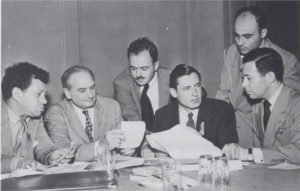A Flag is Born, The American Jewish Historical Society.
 From The American Jewish Historical Society website.
From The American Jewish Historical Society website.
On September 4, 1946, renowned actors Paul Muni and Celia Adler and a young, unknown actor named Marlon Brando premiered a new Broadway production, “A Flag is Born.” Written by Hollywood’s most successful screenwriter, Ben Hecht, directed by Luther Adler and with music by Kurt Weill, the blatantly propagandistic play helped mobilize American opinion for a Jewish homeland in Palestine.
In 1946, Zionism was an unlikely Broadway topic. Just as unlikely, however, was the play’s producer- not one of the great American Jewish impresarios like Billy Rose or the Schuberts, but the American League for a Free Palestine. Headed by a brilliant and energetic Palestinian Jew, Hillel Kook – known in America by the anglicized name Peter Bergson – ALFP raised funds to purchase arms for the Irgun, the Jewish underground fighting to drive the British from Palestine. Both the British and mainstream Zionist groups labeled the Irgun as terrorists. What, then, were men who blew up British prisons and smuggled Jews into Palestine doing on the Great White Way?
The Bergson Group, as it became known, came to the U.S. from Palestine in 1939 to raise funds to form an independent Jewish legion that would fight alongside the Allies against the Axis powers. In 1943, after the Holocaust became undeniable, the Bergsonites lobbied governments to rescue European Jewry. In 1944, the group switched focus by hoping to force the British to allow unlimited Jewish emigration to Palestine. The creation of a Jewish state in Palestine was their ultimate goal.
A public relations genius, Bergson convinced the Hearst newspaper chain, Eleanor Roosevelt and Herbert Hoover, writers Dorothy Parker, Thomas Mann and Langston Hughes, performers Stella Adler and Groucho Marx and composer Moss Hart, among others, to endorse his cause. The most supportive adherent Bergson recruited was Ben Hecht, an Academy Award-winning screenwriter and novelist at the height of his career. Previously apolitical, Hecht was frustrated by the failure he perceived of both American Jewry and the United States government to act decisively on behalf of European Jewry. Hecht decided to help the Bergsonites raise funds and consciousness.
Earlier, in 1943, Hecht had joined forces with Kurt Weill and producer Billy Rose to create the “We Will Never Die,” a pageant depicting Jewish history from the time of Abraham to the present. The play concluded with the assertion that Hitler could not exterminate the Jewish people. When it opened at Madison Square Garden on September 3, 1943, New York governor Thomas E. Dewey declared the day one of mourning for the millions of Jews killed by the Nazis. Lauded by most critics, the pageant traveled around the U. S. and was viewed by hundreds of thousands.
At war’s end, Hecht proposed a new production, which he dubbed “A Flag is Born,” which would advocate for a Jewish homeland. He convinced the star actors, director Luther Adler and his friend Weill to work without wages. The rest of the cast worked at union minimum. War journalist Quentin Reynolds served as narrator, and he too donated his fee to the Irgun.
“A Flag is Born” was unabashed melodrama and – like any effective melodrama – it moved its audience deeply. Reynolds began with a retrospective, “Of all the things that happened in that time – our time – the slaughter of the Jews of Europe was the only thing that counted forever in the annals of man. The proud oration of heroes and conquerors will be a footnote in history beside the great silence that watched the slaughter.” The play had but one set, a graveyard, and three characters- elderly Treblinka survivors, Tevye and Zelda, who drag their tired and broken bodies searching for a path to Palestine and Brando’s David, an angry young concentration camp survivor.
Recalling that it is Friday night, Zelda lights candles on top of a broken tombstone. As Tevye says the traditional prayers, he falls into a reverie of dreams of his hometown synagogue before its destruction; of King Saul at the battle of Gilead; and of a conversation with King David. Tevye then makes a plea in his dreams to a “Council of the Mighty” (according to historian Edna Nachshon, a clear reference to the Security Council of the newly-formed United Nations), which goes unheard.
Tevye awakens to find that Zelda has died. He recites the Kaddish, welcomes the angel of death who has come for him, and bids David farewell. As the abandoned David contemplates suicide, three Jewish soldiers approach and promise to take him to Palestine. As David leaves the graveyard of Europe for his new homeland, he incants Hecht’s burning, perhaps overly harsh, indictment of Anglo-American Jewry-
Where were you – Jews . . .when the killing was going on? When the six million were burned and buried alive in lime, where were you? Where was your voice crying out against the slaughter? We didn’t hear any voice. There was no voice … You Jews of America! You Jews of England! Where was your cry of rage . . .? Nowhere! Because you were ashamed to cry as Jews! A curse on your silence … And now, now you speak a little. Your hearts squeak – and you have a dollar for the Jews of Europe. Thank you. Thank you.
“A Flag is Born” played in six North American cities and raised more than $400,000 for the ALFP, the largest block of funds it ever attained. Two years later, a flag was born in Palestine, the flag of Israel. Hecht’s vision had become a reality.




2 Comments on "A Flag is Born, The American Jewish Historical Society."
Trackback | Comments RSS Feed
Inbound Links